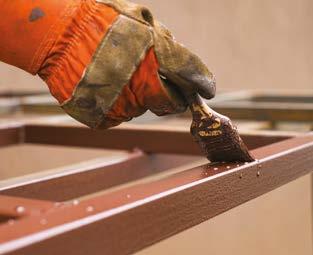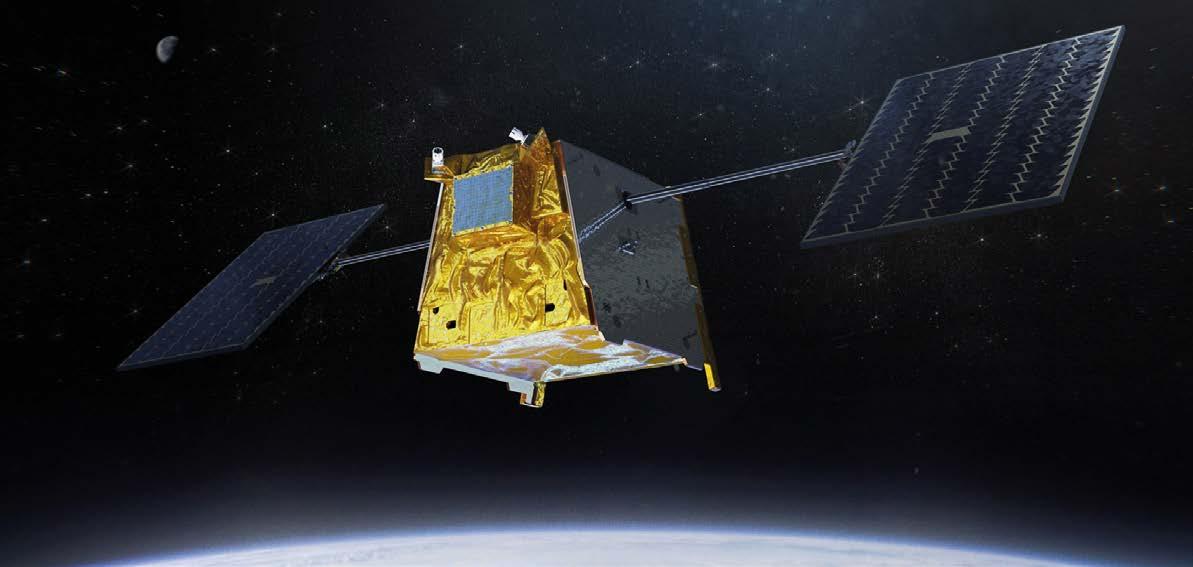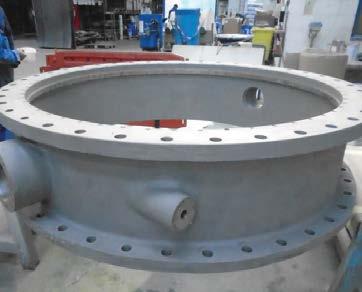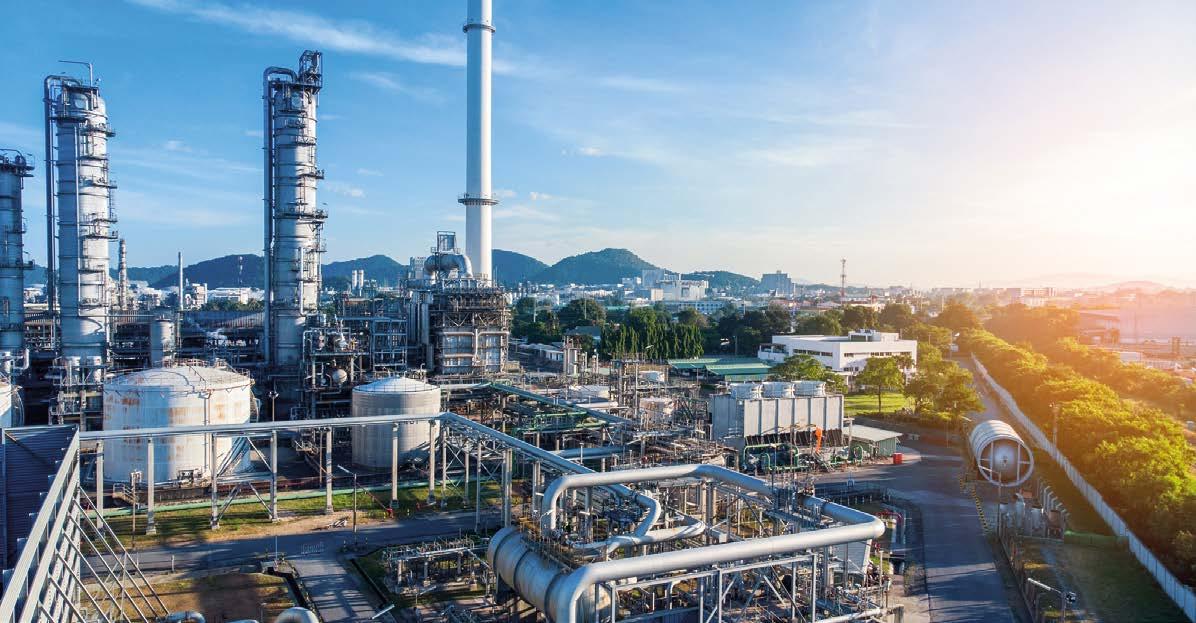
18 minute read
ANALYSIS
Combat Pipeline Corrosion by Adequate Surface Preparation
J.F. Doddema
MONTI Werkzeuge GmbH – Hennef, Germany info@montipower.com
Surface preparation of steel before external coating application is the foundation of any corrosion control program. Any compromise made in the degree of surface preparation will usually compromise the field applied coating performance as well, regardless the technical quality of the pipeline coating. Surface preparation is defined as the cleaning and/or pre-treatment of the metal and adjacent coating surface ensure the best possible bond between the surface to be coated and the coating to be applied. Coating degradation problems that lead to the creation of a corrosion risk within the design life of a pipeline can be attributed to one of the following causes: • An inappropriate specification for the coating material and/or coating process • Poor surface preparation and/or application • Interaction with the operating environment.
Poor surface preparation and poor coating application practices can lead to premature coating degradation, particularly loss of adhesion, and increased risk of corrosion. Appropriate standards have been well defined for many years but do not appear to be applied, or applied correctly. There are many degrees and methods of surface preparation ranging from simple dusting or blowing away of loose dirt and rust, to the complete removal of all contaminants. The methods include the use of steam cleaning, laser cleaning, oscillation cleaning, chemical cleaning, hand tools, power tools such as grinders and needle guns, bristle blasting, water-jetting and loose abrasive blasting for e.g. loose abrasive grit blasting or sponge-jetting. Preparation grades as included in ISO 8501-1 (Sa 1.0 – 3.0) have been used for many decades to describe the surface cleanliness level achieved by the abrasive blast cleaning method as described in ISO 8504-3. Blast-cleaning grade Sa 3 is deemed as the cleanest possible surface finish from the blast cleaning method and it is normally produced in a plant-applied pipeline coating

© MONTI Werkzeuge GmbH
Cordless Prepper Q4 – ca. 8 m2/hour.
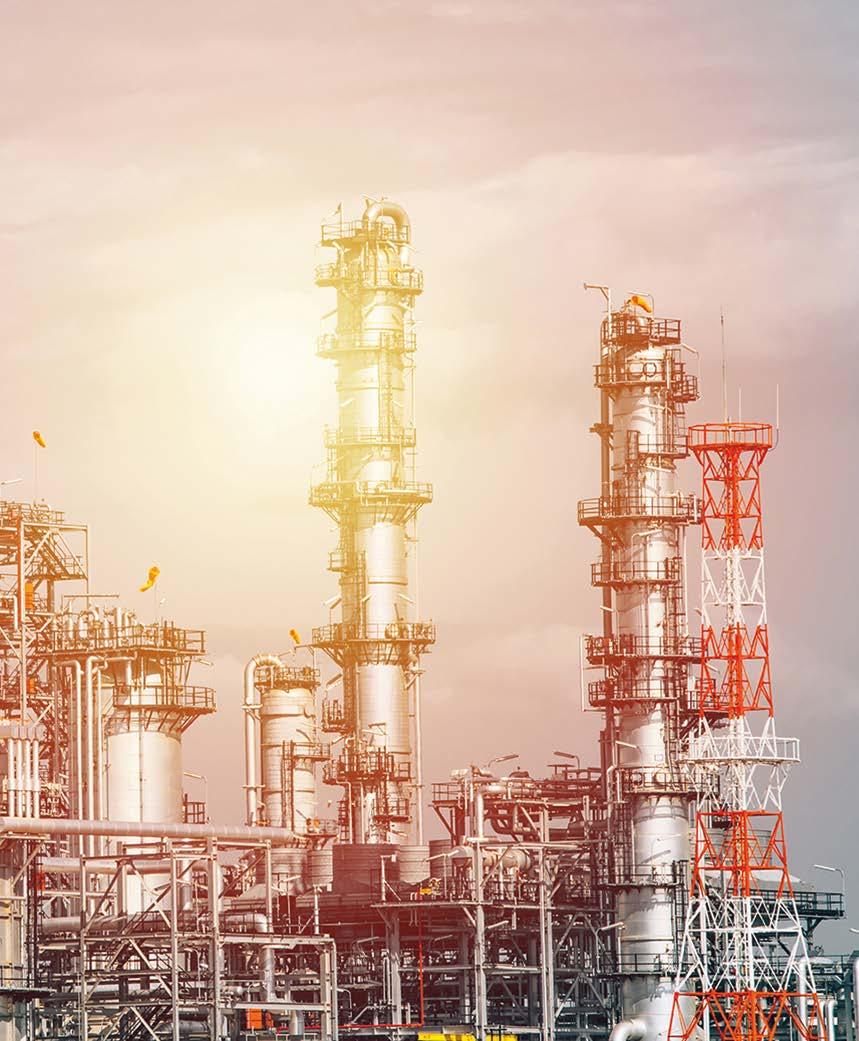
© MONTI Werkzeuge GmbH
Bristle Blaster Double – ca. 3 m2/hour. environment using engineering controls and automated blast cleaning machines with metallic abrasives. Blast-cleaning grade Sa2½ is typically achieved on working sites, where access is sometimes difficult and temporary provisions such as encapsulation, heating and dehumidification are used to control the works. An important rule to remember when selecting both the degree and method of surface preparation is that the service and life expectancy of a given field joint coating or coating system is directly proportional to the degree of surface cleaning done prior to field joint application.

Prepare what’s important
The first objective of surface preparation is to remove surface contaminants that will affect the performance of the pipeline coating. Some of these are: • oil and grease. These can inhibit good coating adhesion and should completely be removed • soluble salts. These can increase moisture penetration by osmotic pressure through the coating and can accelerate the rate of corrosion • dust and dirt. These can inhibit good coating adhesion • rust usually cannot be penetrated by most coatings resulting in uneven layers with exposed metal where corrosion can take place • mill scale. These cannot be penetrated by most coatings and will eventually break free from the substrate taking any coating with it • delaminated coating can be present at edges-backs and can inhibit corrosion prevention. The second objective is to remove surface imperfections in accordance with the ISO 8501-3. Some of these are: • weld spatter • sharp edges • burrs • slivers • pits • crevices. All visible surface imperfections of substrate caused by the girth welding operation, such as welding slag and spatter, sharp edges or burrs that could damage the coating, detected before or during surface preparation shall be removed by an approved grinding method, welding and/or appropriate filing polymer and/or techniques according to the following grades. Grinding of steel defects shall not reduce the wall thickness below the specified minimum wall thickness of the pipe. The third objective of surface preparation is to provide an ‘anchor pattern’ or ‘surface profile’ which improves the bonding depending on the adjacent coating adhesion mechanism such as epoxies, polyurethanes, fusion bonded-epoxies and it increases the surface area.
© MONTI Werkzeuge GmbH Bristle Blaster Cordless – ca. 1 m2/hour.
Take extra care and time before coating in the field

The ISO 8501 relates the cleanliness of the surface to its visual appearance only. In many instances, this is sufficient for the purpose of atmospheric applied coatings, but for field joint coating exposed in severe environments such as water immersion and continuous wet conditions, special attention should be given to the following factors, requirements and tests.
Presence of moisture Many types of coating require a dry surface and do not allow water to be present on the substrate. Condensation can appear on the substrate when the substrate temperature is below the dew point of ambient air although it may always not be “visible moisture”. Dew point and probability of condensation should be checked in accordance with an internationally accepted standard (e.g. ISO 8502-4), and as agreed. Presence of continuous condensation can be reduced by using special drying systems. Water may also originate from different sources not related to condensation such as from rain or from submersion. Water/moisture can be mitigated by waiting for the surface to dry or by creating a watertight habitat (when necessary).
Contamination by soluble salts Soluble salts present on substrates are mainly originating from salts containing chlorides. Soluble salts contamination is therefore often designated and measured as chloride contamination. They can have a detrimental effect on the long term coating performance and should therefore be limited on the substrate and adjacent coating, to a quantity that does not affect the performance of the new coating. Compatibility with substrates having determined levels of salt contamination shall be demonstrated in a technical assessment. The level of these hygroscopic salts remaining on the substrate should not exceed 20 milligram per sq. meter. The level shall be measured in accordance with the requirement of ISO 8502-6 or ISO 8502-9. Contamination by soluble salts can be mitigated by washing the substrate by demineralized water to avoid false total salts readings. Attention should be given to habitat conditions in order to prevent recurrence.
Dust contamination Dust is a type of contamination that can originate from different sources. This includes - but is not limited to – soil, abrasives used for surface cleaning, removed corrosion products, and delaminated plant coatings. They all have in common that they are rather loosely attached to the substrate. Dust can have a number of detrimental effects on the coating performance, e.g. adhesion strength and occurrence of coating voids during application. The degree of dust remaining on the surface should be assessed in accordance with the requirements of ISO 8502-3 or other agreed method. This contamination can be mitigated by cleaning the substrate according to instructions provided by the manufacturer. Attention should be given to habitat conditions in order to prevent recurrence.
Contamination by oil, grease, and other petroleum-like products Oil and grease predominantly consist of hydrocarbons. They all have in common that they are relatively non-polar compounds being insoluble in water, and that they stick very well to the substrate. They form a film on the substrate that impairs proper adhesion with many types of coating, or - when adhesion could be realized – impair long term proper performance of the coating. Substrate contamination by oil, grease, and other petroleum-like products should be tested in accordance with an
internationally accepted standard (e.g. ASTM F22). Oil, grease and wax shall be removed by solvent cleaning in accordance with SSPC-SP1, steam-cleaning or by a suitable detergent. This contamination can be mitigated by washing the substrate with water jetting techniques using detergents and/or by solvent cleaning using a suitable solvent, according to instructions provided by the APS. Attention should be given to habitat conditions in order to prevent recurrence. Attention should also be given to precautionary measures in order to prevent health, safety and environmental issues.
Compatibility with existing coating If the selected coating overlaps the existing coating, it shall be compatible with the existing coating and show proper adhesion to prevent air or water ingress. In case there is no overlap, a small gap may remain at the interface which should then be coated with a third compatible material. Compatibility between field joint coatings and existing coatings should be tested by assessing at least adhesion before and after accelerated ageing procedures at room temperature and at maximum service temperature, as described in this part of ISO 18797. © MONTI Werkzeuge GmbH Attention should be given to existing coatings with irregular surface profiles and the feathered edges.
Feasibility of surface cleaning The level of possible surface preparation may be impacted by local regulations, environmental concerns, and skills of the work forces. In case of impossibility to remove all traces of the former coating (e.g. primer or paint when loose abrasive blasting is not an available option or forbidden), alternate methods for loose abrasive blasting according ISO 8501-1 can be considered such as for e.g. bristle blasting.
Space and access constraints The space required to perform the surface preparation and coating application should be taken into consideration when selecting surface preparation method and coating type. The space around the pipe should be sufficient and stable enough to ensure a safe and proper work area. Time constraints The surface preparation method should allow coating to be applied in time to prevent flash rusting. Flash rusting occurs when freshly abrasive blast cleaned steel are exposed to high humidity, rain or a corrosive atmosphere. The time involved in getting rust back can vary from minutes to weeks. As a rule of thumb it is always advisable than a loose abrasive blast cleaned surface to Sa 21/2 in accordance with the requirements of ISO 8501 Part A1 (visual assessment) should be coated within 8 hours. Under no circumstances should the steel be allowed to rust before coating is applied regardless of the time elapsed. However, an exception to the rule would the use of surface tolerant coatings or surface preparation methods which are not changing the surface tension of the steel surface, for e.g. Bristle Blasting.
Repeatability For a coating job in the field, it is advisable to check the PQT quality of surface preparation versus the coating quality in the field for all machines, media and or tools used. Whatever the level of surface cleanliness required, e.g. Sa 2½ in accordance with the requirements of ISO 8501 Part A1 (visual assessment), the correct hardness, size and angularity of loose abrasives as a method, or the correct method of bristle blasting could be used. A dense, regular, and angular profile (anchor pattern) is required in order to obtain the largest, cleaned surface area and maximum adhesion of the coating to the cleaned and profiled substrate according the requirements of ISO 8503-5 (Replica Tape), or other methods ISO 8503-1, 8503-2, 8503-3, 8503-4 correlating with ISO 8503-5 may be used. A rounded, dished profile is not acceptable. In areas where the roughness of the profile does not meet the requirements, the surface shall be re-blasted. The peak-to-trough height of the anchor pattern, the Rz-value, should be minimally governed by the thickness of the applied liquid coating who depends on the adhesive mechanism via an anchor profile.
Pneumatic Bristle Blaster (ATEX) – ca. 1 m2/hour. Substrate Temperatures During the coating application (installation and curing, if needed),
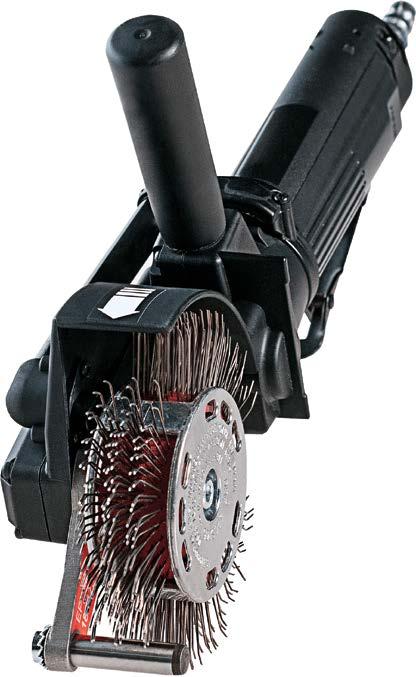
© MONTI Werkzeuge GmbH
Bristle Blaster Subsea – ca. 0,5m2/hour.

temperatures shall be within limits as stated by coating manufacturer. Relative humidity can be of interest for the coating application process within 8 hours after surface preparation to avoid flash rusting and shall not exceed the minimum and maximum humidity as specified in the PDS. In cases when the relative humidity exceeds permissible limits, habitats/tents or other containments should be set to allow the air treatment inside. When using cleaning materials such as water jetting or wet abrasive blasting, the cleaned surface will rust very rapidly. It is therefore essential that a ‘rust inhibitor can be applied to the surface itself immediately after cleaning, or mixed in the water being used during the actual cleaning process.
Adhesion Mechanism of Various Coatings Adhesion mechanisms can be divided basically into mechanical interaction, thermodynamic mechanisms, van der Waals forces and chemical bonding. Among these different adhesion mechanisms, a significant amount of contributions is due to mechanical adhesion. Mechanical adhesion in a loose abrasive blasted substrate or a bristle blasted substrate relies on the curing (hardening) of the coating inside the surface profile and asperities of the substrate surface and physical anchorage resulting therefrom. Mechanical bond may be assisted by contact friction between substrate and coating in areas where the actual adhesion is inadequate. It is important to note that mechanical adhesion in tension differs significantly from mechanical adhesion in shear. For example, a high interface roughness may improve shear bond strength, whereas tensile mechanical bond strength primarily depends on vertical anchorage in the surface profile. Surface Energy Surface energy is more important for bonding. Areas in a loose abrasive and/or bristle blasted surface are not flat but three-dimensional, roughness of a three-dimensional surface cannot be accurately characterized by using a single roughness parameter in linear length. Parameters that characterize surface profiles Ra, Ry, and Rz, or peak count are two-dimension parameters. Although they are widely utilized in different applications, they are not really able to provide the full information on the three-dimensional surfaces. Mostly important, these linear length parameters do not form a linear relationship by themselves to surface area or surface energy. 3D roughness profile tester are on the market.
Damage during Handling During handling, turning, laying, damage to the field joints welds, edges and to the surface by the use of sharp-toothed clamps should be avoided by taking precautionary measures. Touch-up and repairs can easily be handled by the Bristle Blasting Method and subsequent coating systems.
Cleanliness at Site Just as surface cleanliness before the first coating layer is fundamental to performance of the complete system, so is the cleanliness as important of the coated surface prior to the application of subsequent coating layers within a system.
Cleaning methods without anchor profile generation
In order to remove rust, dust, and contaminants, cleaning methods such
as laser cleaning, oscillation cleaning, the following cleaning methods can be used. These methods do not create a roughness profile.
Pure Strength Cleaner/Degreaser: Removes dirt, grease, oil, adhesives, road tar. Agitate for one minute before use. Apply directly on the surface, rub with a brush or cloth, and rinse thoroughly with clean water or wipe with a damp cloth. For large jobs dilute Cleaner/Degreaser with water. All surfaces should be dry before coating is applied.
Steam Cleaning: Recommended for removing grease, oil, salt, acid, alkali, and similar chemical residue from large areas. For maximum effectiveness, steam cleaning should be used in combination with alkaline cleaning. The surface should be thoroughly dry and free of residue before it is coated.
Alkaline Cleaning: For removal of dust, dirt, wax, grease, oil, fat, salt, acid residue, etc., scrub surface with a strong commercial detergent solution such as trisodium phosphate (TSP), then flush thoroughly with fresh water. Surface should be completely dry and free of any residue before it is coated.
Volatile Solvent Cleaning: Make certain the area is well ventilated. Apply solvent to the surface with cloths, sponges, or brushes and scrub to remove grease and oil. Several successive wipings are usually necessary, using clean cloths and solvent each time. For optimum results follow with Alkaline Cleaning.
© MONTI Werkzeuge GmbH
Surface preparation of the substrate
Prior to the coating application, the surface shall be dry and free of any contamination (such as detritus, dust, non-adhering particles, grease, oil, soluble salts) detrimental to surface preparation or to adhesion of the coating on the steel. Oil, grease and wax shall be removed by solvent cleaning in accordance with SSPC-SP1. All visible surface imperfections of substrate caused by the girth welding operation, such as welding slag and spatter, sharp edges or burrs that could damage the coating, detected before or during surface preparation shall be removed by an approved grinding method or filing techniques according to the following grades.
Loose abrasive blasting cannot be normative in a standard for coating in the field
Selection of a suitable method is necessary to achieve the required standard of surface preparation. In this field joint standard it is not normative to use only the method of loose abrasive blasting to achieve ISO 8501-1 Sa 1-3 grades. In this standard the loose abrasive blast cleaning method ISO 8504-2 is informative. ‘Sa’ is the designation for blasting cleaning by loose abrasives only. Surface preparation methods by hand- and or power tools such as needle guns, or wire brushing are designated by ‘St’. Descriptions are given in ISO 8504-3 for cleaning, including treatment prior to, and after. Preparation grade St is not included, as it would correspond to a surface unsuitable for field joint coating. Abrasives used in the preparation of field joints shall comply with ISO 11124 or ISO 11126.
Monti Cleantech Prepper on pipe.

© MONTI Werkzeuge GmbH
Compressed air for blast-cleaning shall be free of oil, condensed moisture and any other contaminants, and shall conform to the requirements of ASTM D4285.

Bristle blasting, the alternative method
This method for removal of mill scale, rust, old coating and creating a profile is mechanical by a handheld pneumatic, electric power or water-driven tools and semi-automatic or automatic machines. During operation, the Bristle Tips will create a dense, angular, regular roughness profile of more than 50 micron Rz and a cleanliness equal to requirements of ISO 8501-1 Sa 21/2.
10,000 strikes per second without heating up the surface per 23mm belt
The core feature is the accelerator bar. It suspends each separate bristle during rotation and accelerates it to increase the kinetic energy of the bristle tips impacting the surface. The system combines the ability to produce an abrasive blasted finish with the high mobility and flexibility of a portable hand-held tool. The procedures prior to bristle blasting and after are similar to lose abrasive blasting. The applicator should wear glasses. Visual sight during the operation is possible to check the cleanliness. The bristles can be reclaimed and dust control vacuum machines can be attached. Compressed air for bristle blasting by a pneumatic tool shall be free of oil, and condensed moisture.
Monti Cleantech Prepper.
• Sa 3 is approximately equivalent to NACE No.1/SSPC-SP5 (White metal blast cleaning) • Sa 2½ is approximately equivalent to NACE No.2/SSPC-SP10 (Near-white metal blast cleaning) • Sa 2 is approximately equivalent to NACE No.3/SSPC-SP6 (Commercial blast cleaning). Bristle Blasting, depending on the brush and the type meets also the requirements of power tool cleaning and the current normative loose abrasive method to achieve a Sa 1 till 3 cleanliness. General rule of thumb or production is that 1 operator can prepare 1m2 per 1 hour by 1 Bristle Blaster of 23mm width. Bristle Blaster Double offers 3m2 an hour per person as surface preparation power. Prepper Q4 and Prepper Q10 are available in wider configuration. Also subsea bristle blasting is availability based on water hydraulics.
Coating in the field requiring minimal surface preparation, the surface shall be prepared according ISO8501-1 grade St2/3. Tightly adhered mill scale, rust, coating can remain provided it cannot be removed with a dull putty knife. Please note that tightly adhered invisible mill scale can affect the adhesion and performance of the coating system. Hand tool cleaning can be an ideal method to prepare small areas, areas with difficult access, or areas where the use of blast cleaning is not permitted or it is impractical. There are many different tools available to
manually prepare surfaces; some of the most common include: • Rotary wire brush - available in various forms to fit specific machines, including cup and radial form, knotted or crimpled tips. Wire brushes have good resistance to wear and tear. • Reciprocating impact tool (needle gun) - this tool consists of a group of steel needles that are struck by a piston, like a chisel. The needles project out of the gun simultaneously and they will strike the surface individually and hence adapt to irregular surfaces. This is most effective on brittle or loose surface contaminants. • Grinders or sanders - for example, cutter bundles or stars are hardened steel washers that are grouped together on an axis and rotate individually. These are used in metal and nonmetal surface preparation, grinding concrete, and for generation of non-slip surfaces. • Rotary impact or scarifying tools - generally consist of an abrasive material spinning at high speeds, using centrifugal force to project cutters or hammers against the surface. These tools accomplish most cleaning jobs rapidly and leave surfaces fairly smooth, but frequently leave oil or grease on the surface. The surface shall be cleaned of oil and grease before using rotary cleaning tools. While it is possible to achieve an acceptable standard of surface cleanliness with power tools, the surface profile is unlikely to be the same as that achieved with abrasive blasting because they do not produce a uniform pattern. • Tools without generating a profiling but well-equipped for removal of polypropylene, polyethylene, glue residues or vinyl without damaging the primer are technologies like the Vinyl Zappers based on butyl or silicone for wearless properties. ‹

© MONTI Werkzeuge GmbH
Monti Vinyl Zapper Ultimate.
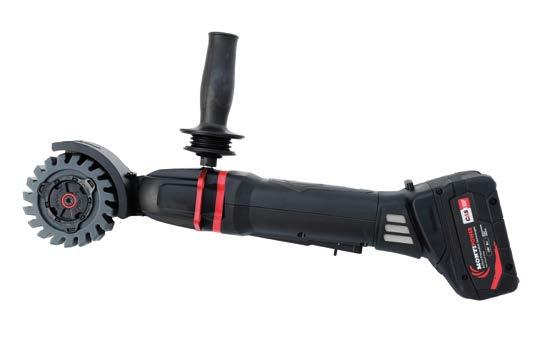
Micro-Corrosion Inhibiting Coatings Solve A Wide Variety Of Corrosion Problems!
Powered by Nano VpCI® from Cortec® Corporation
VpCI® Coatings protect a multitude of metal products. Applying VpCI® Coatings provides fast and economical protection for exterior and interior surfaces.
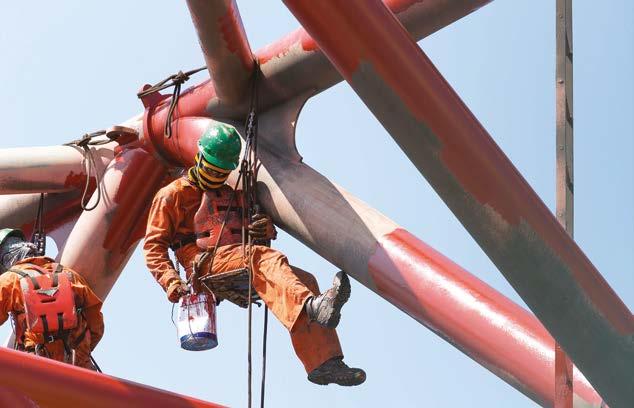
Our technical staff can help you decide which product you need for long lasting and complete protection of your corrosion sensitive products.
